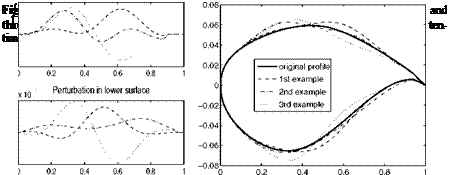Test Case
The test case we use in this work is a CFD model of the inviscid flow around a 2-dimensional RAE2822 airfoil at a Mach number of 0.73 and an angle of attack of
1.0 degrees. The source of uncertainty is the randomly perturbed airfoil geometry, i. e., the lower and upper surfaces of the airfoil’s 2D section (as shown by the solid line in the right part of Figure 1) are each assumed to be subject to a Gaussian random perturbation in the direction normal to the surface. Let pl and pu denotes the original lower and upper surface respectively, the perturbed surfaces are
Pi = pi + n • Є (x)
Pu = Pu + П • Єи(Х)
with x e [0,1]. n is the local normal vector of the surface, Є(х) is a zero-mean Gaussian variable with standard deviations a(x), i. e.
Єї(х),Єи(x) ~N(0,a(x))
in which
a(x)= 0.01 • Zmax • x( 1 – x) • 0(2,2)/1.5
with Zmax the maximum half-thickness of the airfoil, and в the Beta function. This setting makes the o(x) have its maximum (one percent of Zmax )at x = 0.5 and being zero at the two ends of the airfoil.
It is assumed that the random deformation is spatially correlated by a Gaussian type correlation function, i. e.
COv[e,(Xl),e,(x2)} = (7 (.n) (7 (-Г9 ) exp
= C(xb x2)
with I = 0.2. The same also applies to Єu(x).
For the purpose of numerical computation, the correlated random fields Єї (x) and Єи^) need to be represented in terms of uncorrelated random variables. This is furnished by Karhunen-Loeve expansions (KLE) [1], e. g. for Єї,
0i(x) = X у/%$Фі(х)
i=1
where are independent standard Gaussian variables. Xi and Фі (x) are the eigenvalues and the eigenfunctions of C(xi, x2), i. e., the solutions of the following integral equation,
C(xbХ2)Фі(хі)йхі = Х1Ф1(Х2) Vі = 1,2,…
For practical problems the KLE needs to be truncated so that only a relatively small number of terms is kept, e. g. an approximation with к terms:
ві(х) « ^л/Хі^Фі(х)
i=1
By taking к = 5, 9i (x) is parameterized by 5 independent standard Gaussian variables. Applying the same approximation to 9u(x),
2k
і=к+1
we express the randomly perturbed airfoil surface as a function of10 such variables. This KLE representation is optimal in the sense that it retains the original geometric variance to the maximum degree compared to any other linear-form representation with the same number of variables [1]. Figure 1 shows three examples of random perturbation in the upper and lower surface together with the corresponding perturbed RAE2822 airfoil geometry.
 |
In this test case, the CFD model takes the input variables | = {|1; •••, £10} and yields the lift and drag coefficients, Ct and Cd, of the randomly perturbed airfoil. Hereafter, the model is denoted as f (|) in this paper. We compare the efficiency of the candidate methods in estimating some target statistics, i. e. the means (д jid), the standard deviations (at, ad) of Ct and Cd, and the exceedance probabilities Pf, j =
Pro{Q < p – j ■ ot} and Pd, j = Pro{Cd > Pd + j ■ Od} with j = 2,3. The accuracy of the statistics is judged by comparing with reference statistics obtained by a QMC integration with a large sample number (N = 2 x 105).











